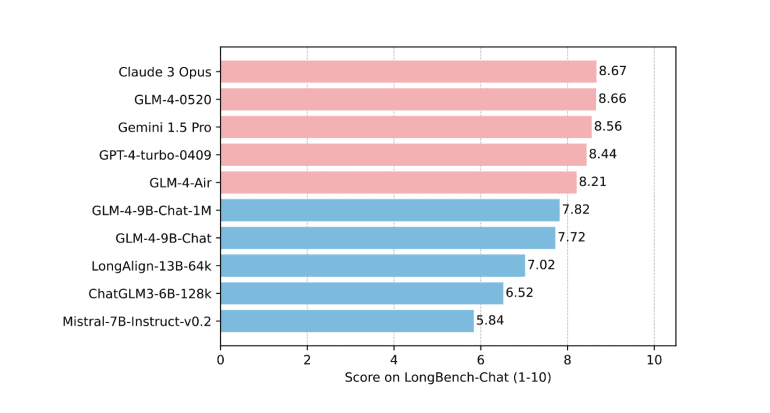- Tsinghua University unveils GLM-4 9B, a powerful language model surpassing benchmarks set by GPT-4 and Gemini.
- Developed by Tsinghua Deep Model (THUDM) team, GLM-4 9B is open-source, marking a significant milestone in natural language processing.
- Trained on 10 trillion tokens across 26 languages, GLM-4 9B boasts capabilities like multi-round dialogue, code execution, and web browsing.
- Incorporates cutting-edge deep learning techniques like attention mechanisms and transformer architectures.
- Supports context windows of up to 128,000 tokens in base version and 1 million tokens in specialized variant.
- Stands out with support for high-resolution vision tasks and multilingual capabilities.
- Outperforms industry giants like GPT-4, Gemini Pro (in vision tasks), Mistral, and Llama 3 8B in overall accuracy.
- Offers open-source nature and flexible commercial licensing, presenting opportunities for developers, researchers, and businesses.
- Potential applications include natural language processing, computer vision, and code generation.
- Seamless integration with Transformers library streamlines adoption and deployment.
Main AI News:
Tsinghua University’s Knowledge Engineering Group (KEG) proudly introduces GLM-4 9B, an extraordinary language model designed to surpass benchmarks set by industry leaders like GPT-4 and Gemini. Developed by the Tsinghua Deep Model (THUDM) team, this open-source innovation heralds a new era in natural language processing.
At its essence, GLM-4 9B is an expansive language model trained on an unparalleled corpus of 10 trillion tokens across 26 languages. Its capabilities encompass diverse functionalities, including multi-round dialogue in both Chinese and English, code execution, web browsing, and customized tool invocation via Function Call.
The architecture of this model incorporates cutting-edge deep learning techniques such as attention mechanisms and transformer architectures, representing the pinnacle of current advancements. Boasting a context window of up to 128,000 tokens in its base version and an astonishing 1 million token context length in a specialized variant, GLM-4 9B pushes the boundaries of what language models can achieve.
What truly distinguishes GLM-4 9B is its support for high-resolution vision tasks, accommodating images up to 1198 x 1198 pixels, and its remarkable multilingual capabilities. This versatility positions GLM-4 9B as an unparalleled contender in the domain of language models.
Extensive evaluations across diverse datasets have showcased GLM-4 9B’s exceptional performance, surpassing existing models in overall accuracy. Notably, it has outperformed industry heavyweights such as GPT-4, Gemini Pro (in vision tasks), Mistral, and Llama 3 8B, solidifying its status as an industry frontrunner.
With its open-source nature and flexible commercial licensing options, GLM-4 9B presents boundless opportunities for developers, researchers, and enterprises alike. Its potential applications span a wide spectrum, from natural language processing to computer vision, code generation, and beyond. Furthermore, seamless integration with the Transformers library streamlines its adoption and implementation.
The launch of GLM-4 9B by Tsinghua University’s KEG marks a pivotal moment in the evolution of language models. With its unrivaled performance, multilingual prowess, and adaptable architecture, this model sets a new standard for open-source language models, charting the course for further breakthroughs in natural language processing and artificial intelligence.
Conclusion:
The introduction of Tsinghua University’s GLM-4 9B signals a significant shift in the language model landscape. With its superior performance, versatility, and open-source nature, GLM-4 9B presents lucrative opportunities for businesses to leverage advanced natural language processing capabilities in various domains. Its ability to outperform existing models establishes it as a frontrunner in the market, setting new standards for innovation and driving further advancements in AI technology.

